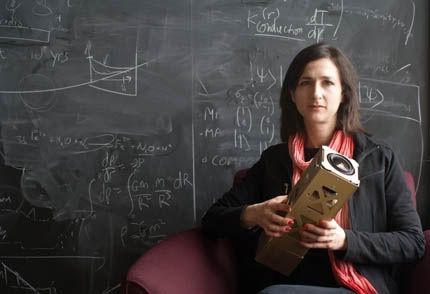
(Photo by Fangfei Shen)
Sara Seager studies planets. Faraway planets. Very faraway planets. The planets Seager studies are exoplanets, planets that encircle stars other than our sun.
Seager, a Professor of Planetary Science and Professor of Physics at MIT, is one of the top experts in exoplanet science, a field that is currently brimming with excitement.
“The reason why we’re excited,” says Seager, “is because we think that this is a really huge thing. Hundreds and thousands of years from now, people will look back and ask, what are the significant accomplishments of our society in the early twenty-first century? One of them will be that we were the first to discover other worlds and other worlds that might be like Earth. When you think back four hundred years, what do you remember? You think about Christopher Columbus and Lewis and Clark. It’s the exploration—finding things that were new to our culture. And that’s why we’re excited.”
Earth is just but a tiny speck in our universe; there must be other worlds out there too. That’s why the search for exoplanets is so compelling. According to Seager, there are about five hundred known exoplanets and about twelve hundred candidate exoplanets. One of those exoplanets must be able to support life.
For a while, astronomers and physicists have been turning to the tell-tale star wobbles to find exoplanets. An exoplanet and its star exert gravitational forces on each other, which causes the star to wobble. This method, the Doppler method, of finding exoplanets is effective, but it tends to find gas giants, as larger exoplanets cause larger and more measurable wobbling in stars. In the search of Earth-like planets, gas giants are less helpful.
Smaller, more Earth-sized exoplanets can be found using other methods, such as the transit method. Exoplanets orbiting around a star must pass in front of the star at some point, and when it does, the exoplanet blocks out starlight, producing a temporary dip in the perceived brightness of the star.
Seager, as part of a collaboration between MIT and Draper Labs, is working on a fleet of exoplanet satellites that will use the transit method. These satellites are called ExoplanetSat, and they’re surprisingly small. (You can see a picture of Seager holding a to-scale model of the ExoplanetSat at the top of this blog.) Each ExoplanetSat has its own assigned star, and its sole purpose is to point to this star and look for exoplanets.
It will be at least a few years before the fleet of ExoplanetSats are sent up into low Earth orbit. A prototype will go up first, hopefully by late 2012 or 2013, in order to open the gates for ExoplanetSat interest and funding. Once the funding doors are opened, then the fleet of ExoplanetSats can be launched. The fleet may contain as many as a hundred of these small satellites, each focused on its own star.
“It’s like a journey of exploration in space,” says Seager about the ExoplanetSats. “And it’s about finding other planets and trying to find the ones that are like Earth, which is really challenging to do. But it’s the theme of exploring—that’s the big idea: exploring the stars. And hopefully we’ll eventually find a way to go there, and this is one of the first steps we’re doing here at MIT.”
Sara Seager will be presenting exoplanets at Big Ideas for Busy People, which will take place on Friday, April 29 between 7:30-9:30 pm at the Laboratory at Harvard, Northwest Building, 52 Oxford Street.

My one and only comment is that when the first earthlike planet is found, please don't name it after Oprah.
ReplyDelete